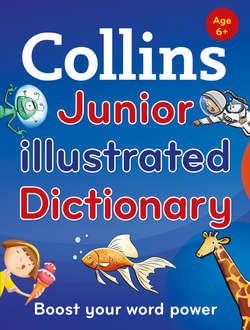Читать книгу Collins Junior Illustrated Dictionary - Collins Dictionaries - Страница 4
ОглавлениеA dictionary tells you what a word means and how to spell it. The words in a dictionary are listed in alphabetical order.
How to find a word
Think of the first letter in the word you want to look up. Once you know this, there is more than one way to find your word in the dictionary:
• You can use the Index at the back of the ebook which lists all of the dictionary words in alphabetical order. Scroll through the Index until you find the letter your word begins with, then look down the words until you find the one you are looking for. You can then follow the link to the entry in the dictionary.
• You can use the Contents page at the front of the book, which has a link to every letter in the dictionary. Follow the link to the letter your word begins with, then look through the entries in this letter until you find the word you are looking for.
Finding out about a word
1. The headword is the word you are looking up.
2. On the same line as the headword, you will see how to spell other forms of the word, such as plural nouns, verb tenses or other adjective forms, called comparatives and superlatives.
3. Next you will see the part of speech. This tells you what type of word the headword is, such as a noun, verb, adjective, adverb or pronoun.
4. After the part of speech, you will find the definition. The definition tells you what the word means. The definitions are numbered if there is more than one. Each definition has its own part of speech.
5. Some words have an example sentence in italics. This shows you how the word might be used in speech or writing.
6. Some words have a photo or other illustration to help you read the word and understand its meaning.
7. A phrase may also be included. Under the word front, you will also find the definition of the phrases in front and in front of.
8. An irregular form of a word is a plural noun or verb tense which does not follow the usual spelling rules. You can find many irregular forms in this dictionary.
Other dictionary features
Pronunciation is how you say a word. Some words can be spelled the same, but sound different and mean different things – these words are called homographs. This dictionary gives you pronunciation help for some words, including homographs. For example:
tear tears, tearing, tore, torn
(rhymes with fear) NOUN 1 Tears are the drops of liquid that come out of your eyes when you cry.
(rhymes with fair) VERB 2 If you tear something, such as paper or fabric, you pull it apart.
Some definitions include a label, such as FORMAL, INFORMAL or TRADEMARK. This tells you a little more about the word or how it is used:
Rollerblade Rollerblades
NOUN; TRADEMARK Rollerblades are roller skates which have the wheels set in one straight line on the bottom of the boot.
Related words are given at the end of some entries, with their parts of speech. These tell you other forms of the word, such as the noun or adverb form. For example:
blur blurs
NOUN A blur is a shape that you cannot see clearly. The car went past so fast it was just a blur. blurred ADJECTIVE blurry ADJECTIVE
Some definitions tell you where to look for more information, such as another headword, or the pages at the back of the dictionary.
are VERB
Are is a present tense form of be. They are both in my class.
See be
Collins Word Wizard
Collins Word Wizard gives you extra help with vocabulary, grammar and spelling. It has pages to help you understand parts of speech, punctuation, and prefixes and suffixes, as well as handy hints for learning tricky spellings. Look out for the themed picture pages and games to play with the dictionary.
Online resources
Explore further at www.collins.co.uk/homeworkhelp for games, activities and extra support for parents and children.
